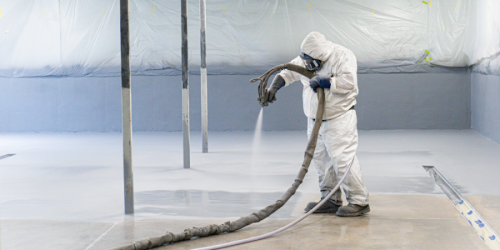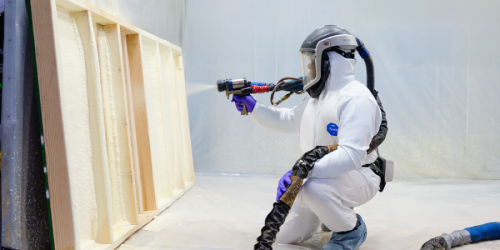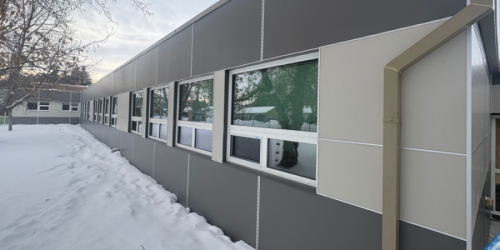Q&A Forums
application process???? Post New Topic | Post Reply
| Author | Comments |
|---|---|
|
Posted: Dec 18, 2007 08:27 PM
|
application process????
I recently went to check out a job. That I was suppose to be spraying. Only to find out somebody else was already doing it. GRRR, oh well However there techniques in spraying were rather odd to me. They were putting up a 6 mil plastic and clamping a expanded metal grate or screen however u want to call it, to the wall then using pour in system. Nice cuz u can see what your doing however you still have to shave the foam. Seems like a lot of extra work to me and it doesn’t seem like you would get the adhesion that I find is a critical in dealing with foam. So I guess my question is has anyone ever seen foam applied this way before??? And if so what are the pros and cons?? Any input would be gratefully appreciated Ryan |
|
mason
Posted: Dec 19, 2007 07:51 AM
|
I'm not familiar with this method and wouldn't recommend it unless you wanted to have a vapor retarder within the wall. Typically, you would not want to install a vapor retarder element when spraying SPF into a wall cavity unless it were a situation where there was a vapor drive constantly going in one direction (cold storage, swimming pools, etc). (note when spraying low density SPF a vapor retarder element should be used in colder climates on the warm side of the insulation, this can be a coating) |
|
Luke Kujacznski
Posted: Dec 19, 2007 08:23 AM
|
Guys, The application technique you are talking about works very well. So well that has been patent infringment lawsuits about it. It allows youto fill the cavity with little to no clean up. Then after the foam sets up you remove the grate and the plastic and check to make sure you hit all the spots. A pretty nice system. Mason, we live in lower michigan, should we be installing a vapor barrier over our soft foam? |
|
mason
Posted: Dec 19, 2007 01:10 PM
|
Luke, Thanks for the clarification. I was concerned that the plastic would remain in the wall. In your area, I would expect that you should have a vapor retarder on the warm side of the insulation when using low density foam. This could be a low perm rated paint. Ask you supplier to do a WUFI or HAM simulation using the temperatures and humidities in your area and ask for their specific recommendations. |
|
Posted: Dec 19, 2007 01:13 PM
|
Luke, They only way i could see this being a better way to go is if you dont have skilled personal spraying your foam. other wise it seems time consuming. However thanks for the input. Also do you know where u can get this system? Mason, Tha plastic doesnt go in the wall it is used as a barrier to keep the foam from coming threw the grate. And you actually poke holes in the plastic and spray threw it. I will have to see if i can round up some pictures. of it. Ryan |
|
quentin
Posted: Dec 19, 2007 06:35 PM
|
There was another thread on this a bit back and some idiot found out a member posted pictures of how he was doing it then sent threatening letters claiming a grate or lattice with plastic was a patent infringement. If I remember right the advantages were reduced clean up and waste with a better fill for customers wanting a full cavity spray. |
|
Mac Sheldon
Posted: Apr 10, 2008 01:06 PM
|
I see that this is a rather old thread, but it was only recently brought to my attention. I hope I can shed some light on the process and the panels. There are several reasons that this system is attractive, but perhaps the most important is that the "injected" walls look great! They are full-filled with no gaps or voids. Even if it took longer (which it doesn't) or cost more (which it doesn't) this would be adequate reason to use the panels. Anyone who's been to a 1/2 pound foam job has seen the bags of waste that are collected and hauled to a landfill after the job is done. Admittedly, there's little mass in all that volume, but still no one likes it. The customer sees the wast as money that he was charged and thrown away. The homeowner might see the environmental waste. The business owner sees the effect on the profit margin of all that waste. In order to fill a 2X4 wall it's common to spray in 4 to 5 inches of foam ...... That's 15 to 30% waste! A 2X6 is about half that, and all of it comes directly from the bottom line of the P&L. The panel system requires a crew of only two, which can be a significant advantage. The crew can be less experienced; another labor advantage. The job will take a little longer to install and much less time to trim with a net result of about the same hours. The tipping fees at the dump are virtually eliminated. And remember how great the finished job looks! We're finding that two groups of applicators are embracing this idea; the newbies and the big companies with multiple rigs. The newbies can get a job done in about the same time with only two men and the finished job makes him look like an old pro. The big company also enjoys the reduced labor and finds the reduced number of bags of trimmings very refreshing. The guys in between are less willing to try it .... they don't need training wheels I've been told. Too bad. They may never get to the multiple rig size if they don't think about new and innovative ways to do their job. The system was developed through numerous iterations by a foam contractor in Billings, Montana and both an application and device patents applied for. I know that some have tried various ways to replicate this system, but at the end of the day, it's my opinion that investing in their system will be money well spent as they've already done the R&D and have found the only alloys, configurations and methodology that seems to make sense. Again, I come back to the number one advantage of this system .... The finished job looks great! You can watch a video of the system on YouTube. http://www.youtube.com/watch?v=G_Vn423WvZM |
|
mason
Posted: Apr 13, 2008 08:38 PM
|
Mac, Is this used for low density foam only? |





























